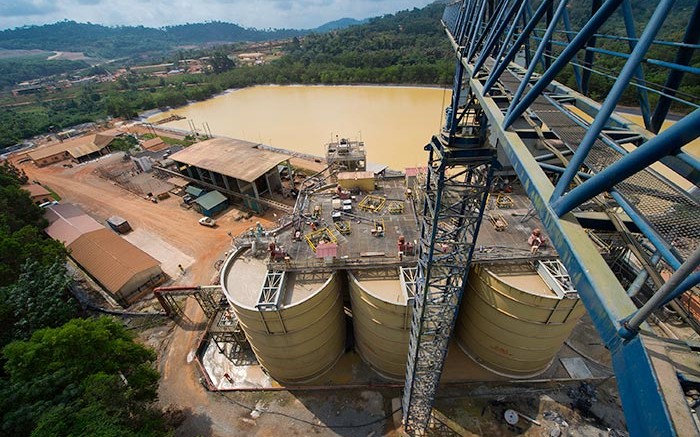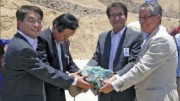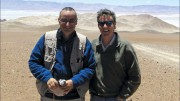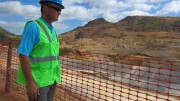PRESTEA, GHANA — Sam Coetzer was senior vice-president of Kinross Gold’s (TSX: K; NYSE: KGC) South American operations when he got a call in 2011 from Christopher Thompson, chairman of the board of an underperforming junior gold producer in Ghana called Golden Star Resources (TSX: GSC).
Thompson, a mining executive from Zimbabwe who before Golden Star had spent seven years at the helm of Gold Fields (NYSE: GFI) — which he helped transform from a South African mining company producing 2 million oz. gold a year to a global producer of well over 4 million oz. a year — wanted Coetzer’s opinion about Golden Star’s troubled operations in West Africa.
Coetzer, a South African mining engineer who over his career had extensive experience in underground mining (12 years in South Africa, three in Fiji and another five in Canada at Placer Dome’s Musselwhite mine) agreed to look at it.
“Chris asked me to do some due diligence on the property and see if I saw what he saw, and when I did, it just jumped out at me,” Coetzer recalls of his first trip to the company’s Bogoso, Wassa and Prestea mines on Ghana’s prolific Ashanti belt.
What struck him first, he says, was that Golden Star was underperforming, despite a relatively high gold price — mainly because of its cost structure.
The junior was processing refractory and non-refractory ore from open pits on its concessions and producing between 300,000 and 340,000 oz. gold a year at a pricey US$1,300 per ounce.
The second thing that surprised him was that the company controlled 85 km of prime real estate on the 250 km long Ashanti gold belt — the largest land package of any mining company on the belt, including the majors — and had three permitted and fully paid for processing plants to boot: two conventional carbon-in-leach and one refractory using BIOX technology.
Perhaps its most intriguing attribute, however, was the past-producing Prestea underground mine, which had over the previous century produced over 9 million oz. gold at a head grade of 11 grams gold per tonne.
“I thought there were more legs in this company than what appeared on surface,” Coetzer tells The Northern Miner. “It was a big land package with lots of infrastructure and good camps, but there was a lack of planning and not a strong use of local skills. I thought there was more value I could unlock in the company.

The main pit at Golden Star Resources’ Wassa gold mine in southwestern Ghana’s Ashanti gold belt. Credit: Golden Star Resources.
The challenge of a major turnaround story appealed to him, too, and in March 2011, Coetzer joined Golden Star as executive vice-president and chief operating officer. He moved up to president and CEO in January 2013.
Until Coetzer came along, Golden Star’s strategy from the time it had entered Ghana in 1999 had been to mine non-refractory and refractory ore from open pits and satellite deposits within 40 km on its three concessions: Bogoso, Prestea and Wassa.
“What I didn’t like about that business model was that although your costs are low during the time you mine the pits, you constantly have to rehabilitate and relocate communities so you see the cost a year or two later, and then you are surprised you never make the amount of money you think you will,” he says.
One of the first things he did, Coetzer says, was “bring sophistication into the company” by hiring Martin Raffield as senior vice-president of project development and technical services. Raffield has a PhD in geotechnical engineering from the University of Wales and started his career in the deep gold mines of South Africa.
Coetzer was working in business development for Placer Dome and doing due diligence at the company’s South Deep mine in South Africa when he met Raffield for the first time. Coetzer was so impressed that he recommended Placer management transfer Raffield to their Canadian operations, which it did. Raffield worked at the Campbell mine and regularly consulted for Coetzer at Musselwhite.
Coetzer was convinced that Raffield was the right person to help him shake up Golden Star and put it back on track, and his instincts, he says, were correct.
“He single-handedly, within a year and a half, gave the board a great sense that we had more in the company than we ever thought,” Coetzer says.
By 2012, Coetzer and Raffield decided that there was a better use for the company’s funds than spending any more of them on the refractory business.
“The more we looked at it, and how much capital it would require, the more it didn’t make sense to us,” Coetzer says.

A crew boarding the Alimak at Golden Star Resources’ Prestea underground gold mine in Ghana. Credit: Golden Star Resources.
After permitting new oxide permits at Prestea, Golden Star shut down the refractory business at the pits on its Bogoso concession in the third quarter of 2015.
Coetzer and his team also completed two feasibility studies for a new underground mine at Wassa to complement production from the deposit’s open-pit mine, and assess whether Golden Star should rehabilitate the aging workings at Prestea underground and restart the operation.
The study on Wassa concluded that Golden Star could build an underground mine for initial capex of US$39 million and the project would yield an after-tax net present value of US$176 million, and an 83% after-tax internal rate of return.
At Prestea, 40 km southwest of Wassa and 16 km south of the company’s processing plant at Bogoso, a feasibility study showed that refurbishing the aging shafts and other infrastructure, and extracting gold, initially from the West Reef zone, would be economic. West Reef is a high-grade narrow vein deposit, Golden Star’s vice-president of exploration, Mitch Wasel, discovered in 2004.
The study found that at US$1,150 per oz. gold, Prestea underground would serve up a 42% after-tax internal rate of return and an after-tax net present value of US$124 million. Initial capex estimates of US$63 million could be paid back in just under three years.
To finance both underground development projects, Golden Star entered into a $130-million stream financing with Royal Gold (US-NASDAQ: RGLD) and a US$20-million term loan in May 2015. In December of that year, the stream financing was increased another US$15 million, with the option to add $5 million.
Construction of Wassa underground kicked off in mid-2015 and the first stope — in the F shoot of the orebody — was blasted in July 2016. Commercial production began this January after a 17-month construction period.
At Prestea, Golden Star blasted its first stope underground in the second quarter of 2017, and expects to achieve commercial production in the third quarter of this year.

A bird’s-eye view of Golden Star Resources’ Wassa gold mine in Ghana. Credit: Golden Star Resources.
Prestea underground is one of the highest-grade development projects in West Africa, with a reserve grade of 14 grams gold per tonne.
In addition, the company started producing gold from its oxide pits at Prestea in the third quarter of 2015, which bridges the gap between the closure of the refractory operations and first ore production from Prestea underground.
The company produced a total of just under 58,000 oz. gold from three sources of ore in the first quarter — the highest quarterly production it has achieved since closing its refractory operation. Cash-operating costs came in at just under US$800 per ounce.
“Neither the open pits nor the underground operations are performing optimally at the moment, as they’re both adapting to being a combined operation, and this has led to higher mining costs,” Coezter conceded on a conference call announcing the results, adding that “two sources of high-grade underground ore being fit into our processing plants should deliver significant changes in our cost structure.”
The Toronto-based mining executive gets excited when talking about Prestea’s high-grade ore. “Grade is everything,” he says. “Prestea is such a unique orebody. It’s been mined for decades — it’s like something you’d see at Red Lake or Barberton in South Africa. You don’t often get these kinds of orebodies that have yielded so many ounces.”
This year is a transformative one for Golden Star, as it marks the first time the company will produce from four sources of ore — two open pits and two underground operations — and will no longer be a non-refractory producer.

Mining shift boss Gifty Gandhi in front of the central shaft at Golden Star Resources’ Prestea underground gold mine in Ghana. Photo by Trish Saywell.
“That means our risk profile is dramatically lower and our transition to becoming a low-cost, high-grade producer now will really take off,” Coetzer said on the first-quarter conference call. “We still have some way to go, but it’s great to see how far our company has come in its transformation.”
In addition, Golden Star has started mining ore from its high-grade Mampon open pits, 65 km north of Prestea. Mampon ore will be blended with ore from the Prestea pits to extend the mine life of Prestea’s open-pit operations well into the second half of 2017. Mampon has reserves of 301,000 tonnes at 4.64 grams gold per tonne for 45,000 contained oz. gold.
This year, Golden Star expects to produce between 255,000 and 280,000 oz. gold — an increase of between 31% and 44% over 2016’s 194,054 ounces.
Of the total, 45,000 to 50,000 oz. gold are expected from the Prestea underground operation.
Cash-operating costs in 2017 are forecast at US$780 to US$860 per oz. and all-in sustaining costs will be between US$970 and US$1,070 per ounce.
Looking ahead, the company expects to boost total production by 60% between 2016 and 2019 and cut cash-operating costs by 29%. Over the next five years, Golden Star forecasts consolidated production to average 281,000 oz. gold per year at cash-operating costs of US$695 per oz. and AISCs of US$903 per ounce.
The Northern Miner recently toured Golden Star’s Prestea and Wassa operations, 150 km west of Accra, Ghana’s capital city.

Location map of Golden Star Resources’ Wassa gold mine in Ghana. Credit: gps-coordinates.net.
“I’m sleeping so much better since 2013, when nobody wanted to give us a dollar,” Coetzer joked with mining analysts and investors during the two-day site visit in April. “What we’ve created here is brilliant.”
Not only that, he says, but the company has been able to build two mines for US$40 million each, “only because other people spent money here — not because I’ve spent money here,” he says. “It’s phenomenal.”
At Wassa, Golden Star started mining the high-grade B-shoot zone during the first quarter and will mine even higher grade and larger gold mineralization widths using transverse stoping in the third quarter. This could increase production.
Production in the first quarter using sub-level longitudinal stoping ramped up, with a 40% increase in production, compared to the fourth quarter of 2016.
“At Wassa we have 94% recoveries and easy ore, and the infrastructure is phenomenal, with a main road all the way to Takoradi,” Coetzer says. “The underground conditions are really good. You can cut things square — it’s like cutting granite with a blade.”
“By year-end we’ll be up to 2,400 tonnes in the mine plan,” Raffield adds. “In fact, we’re getting close to that at the moment. And the long-term plan is to carry on at 2,400 tonnes underground for the next five years or so, that’s what we’re budgeting on at the moment, but our conceptual plan is to push the underground up to 4,000 tonnes, and possibly higher, as we follow the ore down.”

Daniel Owiredu (left), Golden Star Resources’ executive vice-president and COO, and Mitch Wasel, vice-president of exploration, in the field in Ghana. Photo by Trish Saywell.
At Prestea underground, the refurbishment work is in its final stages and the company has hoisted over 9,000 tonnes of material to surface. The company has completed the upgrade of winders, and has five alimaks on site, one of which was up 60 metres — or halfway up the first raise — during the April site visit.
The raises at Prestea are 2.7 metres by 3 metres. “They’re big,” Golden Star’s underground superintendent Greg Scammell says. “It would be almost impossible to do that without the use of an alimak.”
Alimaks are machines that climb vertically on rail that is anchored in the hanging wall. Occupants ride up in a protected cage with a solid steel head-cover protecting them from any sort of ground fall.
“The rate of achievable development is increased dramatically with an alimak because there is no fatigue. The guys aren’t climbing — the machine is doing all the work,” Scammell says. “They’re not carrying their hand-held drills, they’re not carrying their explosives, they’re just riding in the machine … you can go up the raise no matter what the height is … and it has five breaking systems, so they’re not going to fall out of the raise. It’s an incredibly safe piece of equipment.”

A drill crew at Golden Star Resources’ Wassa gold mine in Ghana. Credit: Golden Star Resources.
Prestea underground looks a lot different than it did in 2011, when Coetzer first visited the site and ventured underground in the mine’s central shaft, which dates from 1935 (as did most of the mine’s electrical system, compressors and other equipment).
“The shaft condition was really bad, it was rusted, it was old and we went down extremely slowly,” he recalls. “It was very, very scary going down.”
Golden Star has rehabilitated the shaft, at a cost of US$2 million, and it now takes eight minutes to descend to 900 metres deep.
Coetzer notes that Golden Star is well on its way to rehabilitating its reputation in the markets, too.
“We are surrounded by a lot of noise on the street, but we have a path,” he says. “The history of the company as a refractory business has hung over it. We were put in the basement of many investors and as it emerges, the first comment we get is: ‘Oh, you’re the refractory guys.’ I know the psychology and the only way you beat it is by credibility. Eventually we’ll break through the barrier of that noise and be recognized as something new.”
In fact, he says, that is already happening.
“I get shareholders calling me now who would never have talked to me before. Banks in London are calling me. A year ago, no one was calling me!”
In January, Golden Star raised $30 million in a bought-deal financing. In March it arranged a US$25-million secured loan from Ecobank Ghana.
“If you had to write a book it would be the most amazing book to see all the things that happened in such quick succession from what it was back then and how we put new life into it today,” he says. “We had to touch every part of the company and I realized that very early on, and had to be realistic. We dealt with environmental liabilities, a new mine plan, exploration, design and feasibility studies. We funded it and we got shareholders and the market to believe in us, and believe in it ourselves.”
Coetzer says that both Wassa and Prestea have exploration upside in spades, and the company has earmarked $6.5 million this year for a 48,000-metre drill program.
Prestea underground has reserves of 1.1 million tonnes grading 13.93 grams gold per tonne for 490,000 oz. gold. Based on those reserves, the mine could generate 90,000 oz. gold a year over a 5.5-year mine life.
Prestea is hosted within Birimian phyllites and the mineralization is associated with the prolific fault referred to as the Ashanti trend. West Reef mineralization is hosted in a fault structure parallel to the Main Reef. Gold occurs as free gold along carbonaceous partings within the quartz veins, or with pyrite and arsenopyrite.
At Wassa underground, measured and indicated resources tally 13.5 million tonnes grading 3.83 grams gold per tonne for 1.7 million oz. gold. Inferred resources add 15.6 million tonnes grading 4.20 grams gold for 2.1 million oz. gold. (The Wassa open-pit mine has measured and indicated resources of 27.5 million tonnes grading 1.43 grams gold for 1.3 million oz. gold.)

Golden Star Resources’ president and CEO Sam Coetzer at the Wassa open-pit gold mine in Ghana. Photo by Trish Saywell.
The company says the mine life at Wassa underground can be extended through exploration beyond the current seven years forecast in the feasibility study. “My hope,” Coetzer says, “is that Wassa is a world-class orebody close to 10 million ounces.”
The Wassa deposit is hosted in Birimian metasedimentary and volcanic rocks, and dating shows it is the oldest deposit in the Ashanti belt. Initial gold mineralization has been affected by two major folding events. Gold was remobilized during the first tight folding event, and these higher-grade fold closures are being mined underground.
Coetzer sees Wassa underground as similar to the Musselwhite gold mine in northern Ontario, where he worked from 1996 until 2000.
“I see a lot of resemblance between Musselwhite and Wassa,” he says. “Musselwhite had a similar plunge and geometry to this orebody, and when we started at Musselwhite in 1995 we had seven years of mine life, and it’s still being mined in 2017.”
The 2017 exploration program at Wassa has three areas of focus: The first is to test the B shoot to the north, the second to test the B shoot extension to the south and finally step-out drilling on the 242 trend, which has been mined before from surface as part of the Wassa open pit. The company will assess potential to mining 242 from underground as well.
“Every time we step out by 200 metres we tend to add half a million ounces on this whole deposit,” Wasel says of Wassa. “I’ve been told firmly that we need to get a little bit more aggressive and step out a little further … it’s a well-endowed deposit.
“When you look at the rock it’s very competent, so we’re able to open and break these big stopes,” he says. “The Wassa deposit is a little bit different than anything else we’ve seen in West Africa. We’ve done a lot of dating on the sulphides and this is probably one of the older gold deposits you’ll find in West Africa.”
“We need to know if this is a massive orebody,” Coetzer adds. “The last hole we drilled was 70 metres at 6 grams a tonne. We need to follow that up.”
Golden Star is optimistic about exploration upside at Prestea, too. The last exploration at Prestea underground was 13 years ago, and before that, more than 40 years ago. Wasel found the West Reef zone in 2004, but at the time, his calls for more exploration dollars under previous management fell on deaf ears.
“Mitch went down with a drill in 2004 when there was no ventilation and found the high-grade West Reef, and he had tried to convince previous management to spend more money on underground exploration, but my predecessors didn’t have much underground experience,” Coetzer says. “Now the team we have is comfortable doing both … and now that he’s allowed to look deeper, he’s going to be able to find more ore.”
Coetzer says Golden Star can at least double the size of the West Reef because of its plunge and could find more mineralization in the main reef, and an area called the South Gap.
Exploration will first delineate and extend the West Reef. This could increase the supply of high-grade ore to the processing plant in the near term, which would increase production and give the company the biggest bang for its buck.

Open-pit operations at Golden Star’s Prestea mine in Ghana. Credit: Golden Star Resources.
The second focus at Prestea underground will be to test the Main Reef orebody mined historically (80% of the mining at Prestea was in the main reef), and the third focus will target the far south of the workings in an area called the South Gap. Drilling at both Main and South gap will find out if ore can be added to the mine life in the medium term.
“There are a lot more targets on this mine,” Raffield says. “The half a million ounces in the West Reef is not the end, in our opinion … our strategy is to look for extensions on the West Reef, then extensions on the Main Reef, and then start looking for extensions outside of areas that we’re mining at the moment.”
“The targets we have aren’t just thumb-sucks,” Wasel adds, who has spent the last 24 years working for Golden Star, six of them at the company’s Gross Rosebel discovery in Suriname (later sold to Cambior) and 17 of them in Ghana. “We digitized all the material based on historic mining and we have significant targets.”
“We’re just scratching the surface in this camp,” Wasel says. “We have all sorts of targets and it’s good to see that Sam and the board have finally given us some money to restart exploration … now that the mine is generating cash flow we can get back into exploration again.”
In some respects, Coetzer says, Golden Star’s journey to recovery reminds him of the early struggles of Randgold Resources (LON: RRS), whose CEO, Mark Bristow, a fellow South African, had to reform in his early days at the company.
“Randgold didn’t get off the blocks overnight, it was a company that Mark had to build up. In the beginning he had to battle the history of its predecessor, Rand Mines, and change the philosophy, and then he built a fabulous company,” he says. “People think brand-new companies do well, but there are companies that have modernized their mines, cleaned them up and added lots of value — Detour Lake Gold is another example.”
At the end of the first quarter, Golden Star had US$36.5 million in cash.
“We’re sitting on a fantastic land package, we’ve got great infrastructure and our focus will be to keep on growing,” Coetzer says. “This is the largest land package I’ve ever seen, with three plants sitting on it.”
Golden Star is trading at 84¢ per share within a 52-week range of 67¢ to $1.46 per share.
Raj Ray of National Bank of Canada has a target price on the company of $1.85 per share, while Nana Sangmuah of Clarus Securities has a $2-per-share target price.
“Golden Star could benefit from either improving investor interest or potential mergers and acquisitions, given its resources of more than 7 million oz., additional exploration upside potential with the largest concession area (1,156 sq. km) among peers along the prolific Ashanti gold belt and significant mine and mill infrastructure,” Ray said in an April research note.
Golden Star “is a turnaround story with a lot of upside due to the leverage from improving margins driven by lower-cost, rising gold prices and improved execution,” Clarus Securities’ Sangmuah said in a research note after the site visit.
“We highlight the similarity of Golden Star’s production growth, cost and free cash-flow generation profile over the next three years with that of Klondex and Semafo, and yet Golden Star trades at a 50% discount to the average multiples for these stocks.”






Be the first to comment on "Site visit: Sam Coetzer breathes new life into Golden Star"